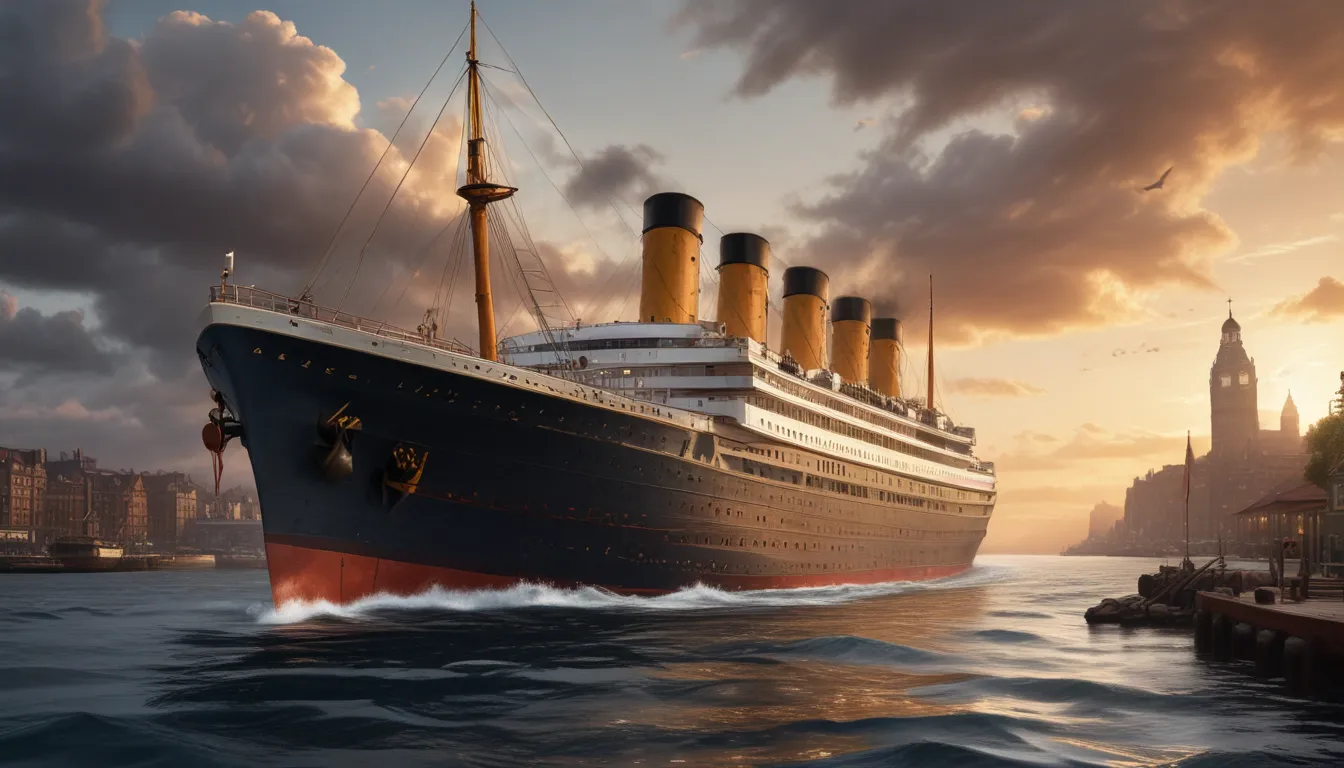The images in our articles may not match the content exactly. They are used to grab your attention, not to show the exact details in the text. The images complement the text but do not replace it.
Welcome to a journey into the extraordinary world of the RMS Titanic, a ship that has captured the imagination of people around the globe for over a century. In this comprehensive article, we will delve into the fascinating facts and untold stories that make the Titanic one of the most iconic and tragic maritime disasters in history. From its grandeur to its ultimate demise, each detail contributes to the allure of this legendary vessel. So, sit back and immerse yourself in the gripping tale of the Titanic.
Unveiling Titanic’s Magnificence
Titanic Size Comparison
The RMS Titanic, with its grandeur and opulence, stood proudly as the largest passenger ship of its time. Measuring a staggering 882 feet and 9 inches in length, the Titanic reigned supreme as not only the largest vessel at sea but also the largest man-made moving object on Earth. While it no longer holds the title, the legacy of the Titanic lives on in the annals of maritime history.
The Titanic’s Belfast Heritage
The RMS Titanic witnessed its creation in Belfast, Ireland, a city steeped in shipbuilding heritage. As one of the three Olympic-class ocean liners, alongside the RMS Olympic and HMHS Britannic, the Titanic was a testament to human ingenuity and craftsmanship. Constructed by the renowned Belfast shipbuilders, Harland and Wolff, the Titanic symbolized the pinnacle of maritime engineering and elegance.
Unraveling Titanic’s Construction Mysteries
Remarkable Safety Record
During the Titanic’s construction, a mere two individuals tragically lost their lives, a remarkable safety record given the scale and complexity of the project. With over 3,000 workers toiling tirelessly for more than two years, the emphasis on safety and precision ensured that the Titanic would stand as a marvel of modern engineering.
Lifeboat Dilemma
The Titanic’s ill-fated voyage exposed a critical flaw – the inadequacy of lifeboats to accommodate all passengers. With only 20 lifeboats onboard, capable of rescuing a fraction of the passengers, the Titanic found itself facing a dire shortage in the midst of chaos. Despite meeting legal requirements at the time, the lifeboats failed to avert the catastrophic loss of over two-thirds of the souls aboard.
The Tragic Tale of the Titanic’s Demise
Heartbreaking Loss
The sinking of the Titanic resulted in a staggering toll, claiming the lives of nearly 1,500 individuals. Among the victims, men constituted the majority, followed by women and children. While first-class passengers fared better, the crew suffered devastating losses, with only a fraction managing to survive the harrowing ordeal.
Tales of Survival
Amidst the tragedy, stories of survival emerged, showcasing the resilience and fortitude of select individuals who defied the odds. From the resourceful baker who braved icy waters to the Japanese passenger ostracized upon return, each survivor’s account adds a poignant chapter to the Titanic’s legacy. Notably, the last survivor, Millvina Dean, epitomized the enduring spirit of those touched by the Titanic’s tragedy.
Uncovering Titanic’s Intriguing Conspiracies
Fortuitous Cancellations
A stroke of luck spared several renowned figures, including Milton S. Hershey and Guglielmo Marconi, from boarding the ill-fated Titanic. Their fortuitous cancellations underscored the arbitrary nature of fate, offering a glimpse into the alternate course that history could have taken.
The Insurance Scam Allegation
Among the myriad Titanic myths, a compelling conspiracy theory suggests foul play in the ship’s demise. Proposing that the Titanic’s sinking was part of an elaborate insurance scam involving its sister ship, the Olympic, this theory delves into the murky realm of maritime intrigue and deception.
Shedding Light on Titanic’s Fateful Moments
Fatal Delay
A mere 30-second delay proved decisive in the Titanic’s tragic collision with an iceberg, altering the course of history in a blink of an eye. The fleeting window of opportunity to avert disaster underscores the fragile balance between safety and catastrophe on the high seas.
Ageless Iceberg
The iceberg responsible for the Titanic’s downfall had a storied history that spanned millennia, hailing from a glacier in Greenland. A relic of the past, this ancient iceberg symbolizes the enduring power of nature and its capacity to shape human destinies.
Reflecting on Titanic’s Legacy
Cinematic Splendor
The legacy of the Titanic lives on through a myriad of films and documentaries that pay homage to its tragic tale. From the poignant narratives of survivors to Hollywood blockbusters like James Cameron’s Titanic, the ship continues to captivate audiences worldwide with its timeless allure.
Eco-Unfriendly Endeavor
In an era devoid of environmental consciousness, the Titanic’s voracious appetite for coal and disregard for ecological impact stand as stark reminders of a bygone era. Burning through hundreds of tons of coal daily, the Titanic left a trail of ash and emissions in its wake, a testament to its unsustainable practices.
Conclusion: Titanic’s Enduring Mystique
As we conclude our exploration of the Titanic’s fateful voyage, we are reminded of the indelible mark left by this iconic vessel. From its remarkable construction to its tragic demise, the Titanic’s legacy endures as a cautionary tale of hubris, heroism, and humanity. As we honor the memory of those lost at sea, let us also celebrate the resilience and spirit of survival that define the enduring allure of the RMS Titanic.






